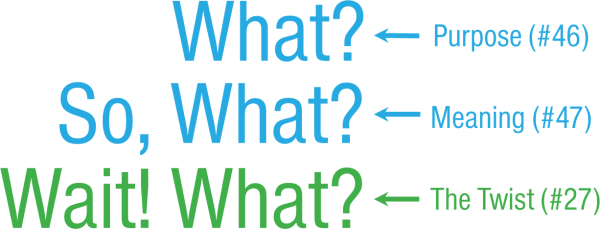
Have you ever been hooked by the opening of someone’s story, only to be disappointed after they finished it? It began with so much promise, but instead of progressing toward a satisfying conclusion, the story meandered aimlessly? The next time this happens, understand that you fell victim to a storyteller who didn’t prepare the three whats of storytelling.
What
The first what refers to the story’s purpose. Without understanding it, storytellers risk taking their audiences on aimless journeys. The problem is easily fixed by asking questions like this:
- “What’s the reason for telling this story?”
- “What do I want to accomplish by the end of it?”
The answers can be as simple as “I want to convince,” “I want to entertain,” or “I want to make a point.”
So, What?
Sometimes storytellers understand their purpose, yet it’s so self-serving that the audience sees no relevance. Most marketing falls into this category because enterprises love to talk about themselves and their agenda. Blah, blah, blah. Yada, yada, yada (B3Y3). The best way to fix B3Y3 problems is to start testing your purpose with “So, what?“
Let’s give it a try:
|
We are the worldwide leader in widget manufacturing. So what? We’re the biggest manufacturer of widgets. So what? Our new manufacturing plants can hit volumes that our competitors can’t Better, but so what? At our volumes, our per-widget cost is lower, and we pass that cost savings onto you. Bingo. |
Start with your message. Keep asking “So, what?” until you can’t come up with any new answers. At the end of the process, you’ll likely have hit a meaning that’s relevant to your audience.
Wait! What?
Finally, with both a purposeful start and a relevant meaning to guide your story, consider adding a memorable moment that forces the audience to look at your story from a totally new perspective. When used effectively, such Wait! What? moments add depth and memorability to your story.
For example, the WWII Allies wanted to create a death ray. However, after determining that the amount of energy required to knock a plane out of the sky was unfeasible, they pivoted toward a new direction–measuring the small amount of energy that was reflected from a targeted aircraft. Their failed attempt at a death ray resulted in the discovery of RADAR instead.
Look at your story through the lens of the three whats. Your audiences will love you for it. I promise.